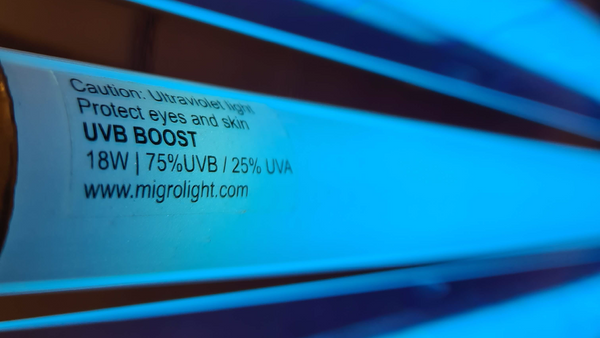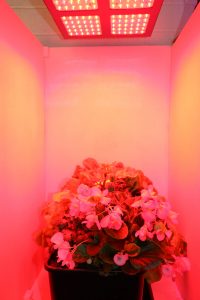Plants require specific wavelengths of light for photosynthesis. Plants absorb wavelengths of light in the same range as the visible spectrum between 400nm (blue) to 700nm (green). The proportion of each color can determine the plant shape. White LEDs provide a balance of blue, green and red for healthy growth.
The Science Behind Light and Plant Growth
Before we dive into the specifics of different light spectra, it's essential to understand the science behind light and plant growth. Plants rely on the process of photosynthesis to convert light energy into chemical energy (in the form of glucose) and oxygen that fuels the plant growth.

Photosynthesis primarily occurs in specialized cell structures called chloroplasts, where pigments, such as chlorophyll, capture light energy. However, not all wavelengths of light are created equal when it comes to photosynthesis. Certain spectra are more effective in driving this essential process, and understanding them is vital for optimal plant growth.
What colors of light cause plant growth
Photosynthetically Active Radiation (PAR) is a crucial concept for indoor growers to understand as it refers to the portion of the electromagnetic spectrum between 400 nanometers (nm) and 700nm or blue, green and red light, that is essential for photosynthesis in plants.

However not all wavelengths of light have the same effect on photosynthesis. The McCree curve, also known as the McCree action spectrum, is a graphical representation of the relative efficiency of different wavelengths of light in driving photosynthesis in plants. It was developed by the American botanist Warren L. McCree in the 1970s. Although a little outdated and not accurate for all plant types the McCree curve proposes that different wavelengths of light have varying levels of effectiveness in photosynthesis.
You can see from the McCree curve that in general red photons (600nm to 700nm) are the most photosynthetically efficient, green (500nm to 600nm) a little less efficient and blue (400 to 700nm) the least efficient.
UVA and Far red photons also contribute to plant growth but with reducing efficiency for wavelengths as you get further outside the PAR range.

The effect of Blue Light on plant growth
Blue light, which falls in the range of approximately 400 to 500 nanometers, is a crucial player in the growth of plants. Blue light is the least photosynthetically efficient in the PAR spectrum but is essential to regulate plant shape.
Increased blue keeps plants short and dense
Blue light can inhibit stem elongation, promoting compact and sturdy plant growth. This is especially important for preventing leggy or spindly growth in indoor plants. Less than 5% blue light in the spectrum will result in very 'stretchy' or tall plants which are not desirable in an indoor growing environment. Increasing the percentage of blue in the spectrum to about 15% will reduce plant height but increased amounts of blue will not reduce plant height further.

The Role of Green Light in plant growth
Green light falls in the range of approximately 500 to 600 nanometers. While green light is often considered less essential for photosynthesis, this is not the case. Green is more photosynthetically efficient than blue light and there are added benefits regarding whole plant photosynthesis.
Green light Penetration and Photosynthesis
Green light penetrates deeper into the leaves and the canopy of plants, reaching deeper into each leaf and lower leaves that might not receive as much blue or red light. These lower leaves can still contribute to photosynthesis, enhancing overall plant productivity.

Green light mixes with blue and red to produce white
As you may remember from school mixing blue, green and red light results in white light. Clear white light is beneficial to the indoor gardener to observe plant health. It is much easier to see pests, disease, nutrient deficiencies etc. in high quality white light from LED grow lights than the orange light from HPS or the purple light from red and blue led grow lights used in the past.

Red Light is photosynthetically efficient
Red light, with wavelengths ranging from approximately 600 to 700 nanometers, is a critical component for plant growth. Red photons are the most photosynthetically efficient of all and therefore indoor growers want to maximise the amount of red in the grow light spectrum.
Red will be about 30 - 40% of any white led spectrum output. To increase the proportion of red photons in a grow light deep red LEDs with a peak wavelength of 660nm can be added.

Not only are 660nm red LED diodes photosynthetically efficient but they are also electrically efficient. They emit more photons per watt than any other type of LED commercially available. Therefore adding 660nm reds improves both the electrical and photosynthetic efficiency of an LED grow light fixture.

Ultraviolet light, UVA and UVB
Often referred to as UV light for short, ultraviolet light is a part of the electromagnetic radiation present in natural sunlight. Every time you are out in the sun, you are exposed to UV light. It is broken up into three different categories of wavelengths - UVA, UVB, and UVC. It helps plants grow in several ways and also may improve the overall potency and quality of your flower. But, only certain types of UV light are really beneficial to plants.

The Different Types of UV Light
Both UVB and UVA are essential parts of life on earth, but UVC is not. It gets filtered out by the ozone layer, and never really makes it to our plants naturally outdoors. UVC is extremely dangerous to life and will damage cells causing living organisms to die under high exposure and may cause cancer. Since we're talking about UV light for plants in particular, we are only going to cover the two types you need to know about: UVA and UVB. Now, let’s break down the wavelengths at which each type of light occurs.

Ultraviolet A (UVA) keeps plants short and improves health
Ultraviolet A, or UVA light, is electromagnetic radiation with wavelengths between 320 nm and 400 nm. UVA is photosynthetic at higher wavelengths but at relatively low efficiency compared to the PAR range. UVA effects plant shape the same as blue does i.e. it keeps plants short and dense
It does not have any harmful effects on DNA and UVA can increase cell wall thickness and health, making the plant more resilient against intense UV, pests, mold, and mildew.

Ultraviolet B (UVB) improves harvest quality
The next type of ultraviolet light is UVB, or ultraviolet B. this kind of light has wavelengths between 280 nm and 320 nm. It contains about a fifth of 1% of overall natural sunlight. In contrast to UVA, it can damage DNA and has been known to have cancerous effects on humans and animals in the form of sun burn.
However if used on plants UVB increases production of secondary metabolites in the form of Flavonoids and Terpenes to improve taste and smell of your harvest.
It is not commercially viable to provide UVB photons with LEDs, fluorescent UV fixtures are the most effective method for delivering UVA and UVB in your grow room.

Far Red causes plants to stretch
Far red electromagnetic radiation is outside of the PAR range and does cause photosynthesis but at a much lower efficiency than red. There are efficient Far red LEDs at 730nm so it is often added to grow lights but it can have an undesirable effect.
Far red at high proportions (in excess of 5%) in the grow light spectrum can cause plant stretching by increasing the internodal distances or the distance between branches. However it can also cause leaf expansion i.e. larger leaves which may be beneficial in early veg to expand the canopy at a faster rate to capture more light.

However in our opinion there is not a strong argument for adding Far red LEDs to the grow light spectrum as most white LEDs emit 3% to 5% as part of their output. This is sufficient to enhance leaf expansion without the negative effects of plant stretching.

Experimental tests of the effects of Blue, Red and White (Full spectrum) light
We setup three grow chambers with flowering plants and productive edibles. We ran a grow comparison under blue, red and full spectrum light over three weeks to see what growth would result. The light intensity in each growth chamber was the same. We tested each grow chamber with a PAR (Photosynthetically Active Radiation) meter and adjusted the grow light output and hanging height to make sure each chamber had the same average PAR level. The results were very interesting...
The effect of Blue light on plant growth

The flowering plants under blue light continued to flower but with less vigor than under red or white light. The flowering plants did not grow as much and had fewer and smaller petals and leaves. The growth rate of the lettuce was very low but the growth was compact and the colour a deeper green. Overall the yield was less than 50% of the other grows.
The effect of Red light on plant growth

The red light was very good for the flowering plants and they had most flowers and the largest leaf and petal size. However the other characteristic of plants grown under red light is stretching. The flowering plants and the lettuce both stretched compared to the other grows. This means the leaves were longer and the distances between nodes or branches were longer.
A plant with long branches and spaced out flowers will not produce as much yield in a small space as a plant with short and dense growth. Despite the stretching the lettuce had high growth rates and the yield was the best of the three tests. However the leaf thickness, colour and compactness was not as good as under the full spectrum light.
The effect of Full spectrum (white) light on plant growth

So what is the best overall grow light spectrum?
By providing the right balance of light to your plants you can ensure healthy, vibrant, and productive indoor gardens. Fortunately white LEDs with added 660nm deep reds provide a good balance of Blue, Green and Red for both short and dense growth and maximum photosynthetic efficiency.

















2 thoughts on “What color light is best for growing plants?”
Chris
Hi
I’m using the Migro Array and wondering if there is any benefit to adding a 650nm 200w light bar for the last few weeks of flowering? Saw this commercial greenhouse bar on ebay bit not sure if its just better to add more white LED? (link there for your info please remove if comment is posted)
https://www.ebay.co.uk/itm/365408512704?trkparms=ni_actn%3Anav%7Cni_nt%3AWATCHITM_GTC%7Cni_apos%3A1%7Cni_sg%3A1%7Cni_pos%3A1%7Cni_st%3AREAD%7Cni_wh%3A1%7Cni_nid%3A787756789604%7Cni_nsid%3A365408512704%7Cni_bn%3A1&trksid=p2380424.m570.l5997
Many thanks and the Array is a great light btw :)
Quest Flex
Loved the content I learned a ton. Now I’m motivated to follow up with a purchase to get a handle on this cloning process